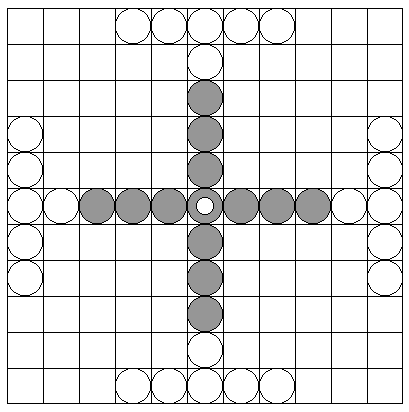
Redactor: Justin
Sources: based on various descriptions, principally those of HJR Murray and Ragnarr Thorbergsson.
It should be noted that, since this game was principally popular in the early half of period, and had mostly died out by the literate times of the Renaissance, reconstruction requires a bit more guesswork than do things like period versions of Chess. The reconstructions are based mainly on two brief descriptions from the Renaissance (long after the game's heyday), one from 16th c. Wales and one from 18th c. Iceland, along with various surviving boards, images of boards, and speculation based on Norse culture the game appears to have grown out of. Therefore, a curious and critical attitude is particularly important here, and the reconstruction, even after most of a century, must be considered a work in progress.
The "standard reconstruction" of the game derives from the work of HJR Murray, as described in his History of Chess and History of Board Games Other Than Chess. That reconstruction has come under some question over the years, because it is particularly unbalanced. Ragnarr Thorbergsson is currently re-examining the game from first principles, and I summarize some of his current work below. Ragnarr's particularly good detailed examination of the game can be found at http://www.venshavn.on.ca/neil/tafl.htm. See that page for far more detail than I present here.


The objective for the defender is completely different from that of the attacker. The defender wins if he gets the King to the edge of the board; the attacker wins if he surrounds and captures the King.
All pieces, including the King, move like rooks in chess. That is, they can move vertically or horizontally as far as there is open space, but cannot jump over another piece. The center space is the King's citadel, and only the King can land there -- other pieces can travel over it, but not land on it. It isn't clear which side goes first, but it doesn't appear to have a dramatic effect on the game, so any mutually-agreed system should be suitable.
You cannot jump onto another piece; instead, capture is "custodial": you capture an enemy piece by positioning two of your pieces on opposite sides of it. That is, you place one of your pieces above the enemy and one below; or one to the left and one to the right; as soon as you do that, the enemy piece is immediately captured and removed from the board. However, an enemy piece can land between two of yours without being captured -- it is the act of surrounding the enemy that captures him, rather than the position.
Capturing the King is more difficult -- you have to surround the King on all four sides to capture it. However, since no piece can land in the middle except the King, that counts as a "captor": you can capture the King by surrounding it on three sides plus that central space if the King is sitting next to the center. The King can help capture attackers.
However, this simply points out the ambiguities that the reconstruction rests upon. Neither of the textual descriptions is exactly detailed: each is one paragraph long, and much is left unclear. So current thinking tends to be that Murray misinterpreted one or another detail, and alternatives should be explored.
One common alternative is the "to the corner" game. This variant is almost identical to Murray's version, except that the King must get to the corner of the board, instead of the edge. To make this work properly, two more rule changes seem necessary: 1) no attacking piece can land in a corner space; 2) if the King is on the edge of the board, it can be captured by surrounding it on the other three sides. This game seems to be slightly unbalanced in favor of the attacker, but isn't clearly wrong, and is fairly popular.
Ragnarr suggests a different alternative (based heavily on the Welsh description), which is like Murray's reconstruction but with two important tweaks. First, instead of requiring the King to be surrounded on all four sides, it only must be surrounded on two sides, much like any other piece. However, the attacker must say "watch your king" before the defender's move, much as you say "check" in Chess. This means that it is much easier to capture the King, which should make the game less unbalanced in favor of the defender, but the attacker can't win with a sneak attack. Also, there is an odd detail in the Welsh source: the defender must say "gwrheill" before landing between two attacking pieces. No, I don't know how that is pronounced, but it doesn't seem like it should make a major tactical difference in the game.
As of this writing, I suspect that there are still subtleties we don't understand; in particular, the "gwrheill" business is still pretty unclear to me. However, it does look like both of the alternatives presented here are more plausible than the old reconstruction. I commend them to the reader to play with and experiment.